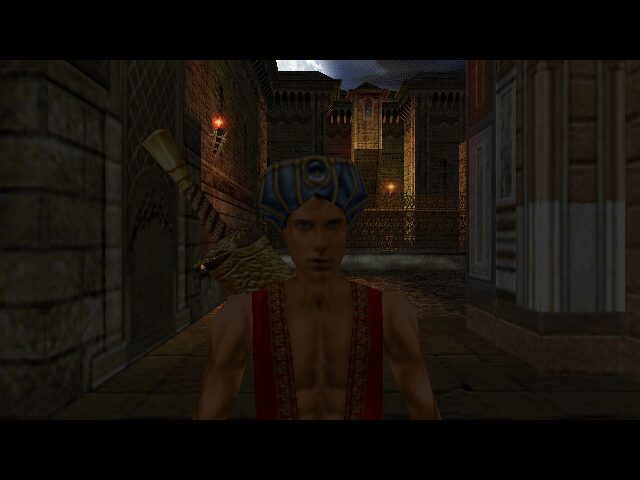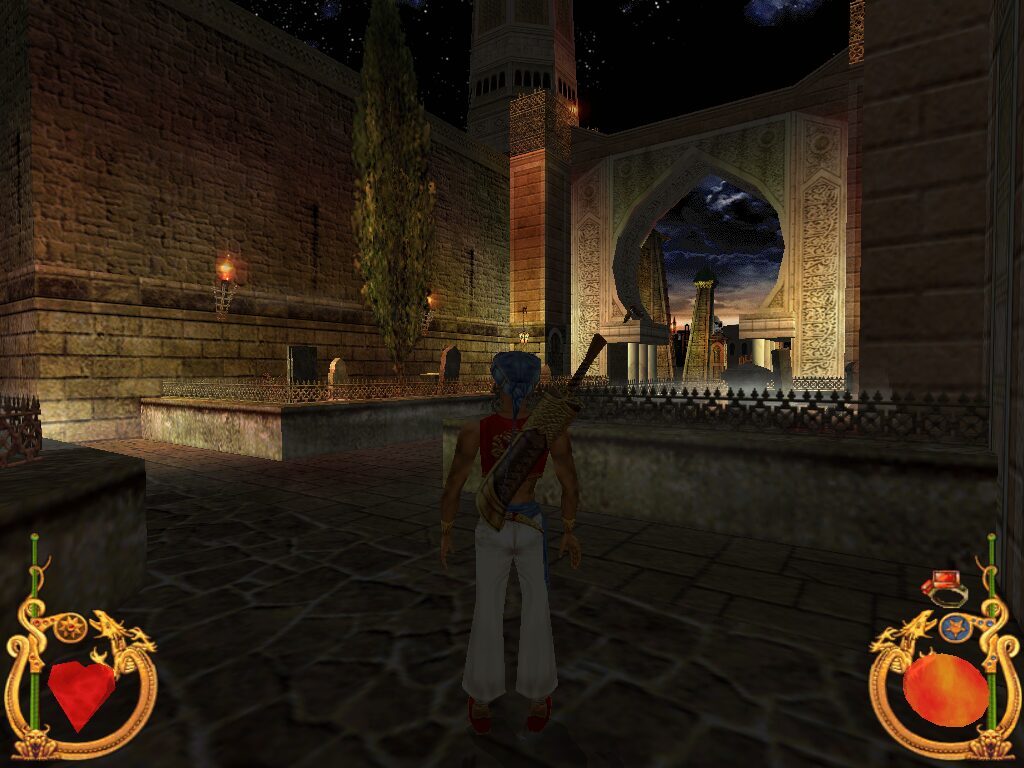Retro Replay Review
Gameplay
Arabian Nights delivers a rich tapestry of action-adventure mechanics that harken back to the mid-’90s era while introducing surprising depth. You control Ali, navigating seven self-contained Episodes that each feature distinct objectives and resolve their own narrative arcs. This episodic format encourages a feeling of progression and accomplishment, as you rescue one of the Sultan’s quintuplets per chapter, then move on to new challenges and puzzles.
(HEY YOU!! We hope you enjoy! We try not to run ads. So basically, this is a very expensive hobby running this site. Please consider joining us for updates, forums, and more. Network w/ us to make some cash or friends while retro gaming, and you can win some free retro games for posting. Okay, carry on 👍)
Combat is varied and engaging: Ali can wield a scimitar for swift slashes, toss knives for ranged attacks, or engage in an impressive moveset of over thirty hand-to-hand maneuvers. If weapons aren’t your style, four magic spells grant strategic alternatives—whether you prefer to freeze enemies in their tracks or unleash elemental fury. Boss encounters often demand quick thinking, forcing you to combine parkour, spellcasting, and deft swordplay.
Beyond combat, Arabian Nights excels in environmental interaction and traversal. Ali can sprint, jump, climb ladders and ropes, shimmy along tightropes, and even soar on a magic carpet. Puzzles pepper each Episode, from reading parchments and deciphering inscriptions to moving blocks and pulling levers in crypts or burial grounds. Inventory items—such as potions or magical trinkets—add another layer of resource management and puzzle-solving.
Finally, the game’s world feels alive thanks to over 60 non-player characters scattered across towns, marketplaces, palace halls, and lush gardens. Conversations with merchants, beggars, and guards not only flesh out the setting but often yield side-quests or clues. This depth of interactivity elevates Arabian Nights from a straightforward platformer into a living, breathing Arabian adventure.
Graphics
Graphically, Arabian Nights stands as a testament to the early days of fully 3D action-adventure titles, drawing clear inspiration from Prince of Persia 3D. The environments are rendered with angular architecture and vibrant color palettes that evoke an exotic Middle Eastern atmosphere. Sand-blasted walls, ornate mosaics, and flickering torchlight create a believable world, albeit with polygon counts that today feel charmingly retro.
Character models display a surprising amount of detail for their time, with Ali’s fluid animations during sword fights and parkour sequences. Enemy designs range from armored guards to shimmering djinn, each boasting distinct silhouettes that help you quickly identify threats. Animations in tightrope walks or magic-carpet flights feel deliberate and weighty, grounding the player’s movements in physical space.
Lighting and special effects are highlights, even if they occasionally exhibit the blockiness typical of the era. Spells crackle with particle effects, casting dynamic shadows on nearby surfaces. Scene transitions between desert vistas, moonlit gardens, and cavernous crypts often include sweeping camera pans that showcase the game’s environmental scope.
On modern hardware, you might notice texture stretching or frame-rate dips in particularly dense areas. However, these technical quirks rarely hinder immersion and instead add a nostalgic charm. Overall, Arabian Nights’ visual presentation remains a compelling showcase of 3D artistry from its generation.
Story
At its core, Arabian Nights is a rescue tale steeped in myth and palace intrigue. Ali is summoned by the Sultan after his five quintuplet daughters mysteriously vanish on the eve of their twenty-first birthday. Each daughter’s disappearance is tied to a distinct locale and set of supernatural challenges, underpinning the game’s episodic design.
The narrative unfolds reliably, with each Episode introducing new characters—both friend and foe—who enrich the storyline. You’ll encounter wise sages who offer cryptic guidance, jealous viziers/assassins who hunt you at every turn, and even mischievous genies whose help you must win. Dialogues are sprinkled with humor and political scheming, ensuring that the game never feels monotonous.
Plot pacing is generally well-balanced: after an initial flurry of combat tutorials and platforming sections, the story pivots to exploration and puzzle-solving, then crescendos into climactic boss battles. This rhythm keeps you invested, as you eagerly anticipate how Ali will outwit each new threat and recover another princess.
While certain narrative beats can feel predictable—rescue the daughter, confront the mastermind—the rich Arabian Nights motif, combined with occasional moral choices and side stories, adds enough nuance to elevate the experience. Fans of classic adventure tales will appreciate the familiar yet captivating storyline.
Overall Experience
Arabian Nights offers a nostalgic yet robust action-adventure journey. Its episodic structure provides a clear sense of progression, while the blend of combat, platforming, and puzzle elements ensures the gameplay remains fresh throughout all seven Chapters. You’ll come for the sword fights and stay for the satisfying puzzle resolutions and narrative hooks.
The game’s charm lies in its willingness to experiment within the 3D space—tightrope walking, magic-carpet glides, and NPC interactions go beyond simple fetch quests. Though occasional camera angles can frustrate precise platforming, most players will find the challenge part of the game’s allure. Resource management in the form of spells and collectible items adds another strategic layer.
Graphically, Arabian Nights captures the spirit of early polygonal worlds, and while it may not rival modern visual standards, it retains a distinctive aesthetic that feels both epic and intimate. The soundtrack, rich with flutes and percussive rhythms, further immerses you in the Sultan’s realm and punctuates key story moments with memorable themes.
For anyone seeking a classic Arabian action-adventure with depth and variety, Arabian Nights remains a rewarding play. Whether you’re a retro enthusiast revisiting the golden age of 3D platformers or a newcomer curious about gaming history, Ali’s quest to rescue the Sultan’s daughters offers countless hours of enchanted exploration and daring exploits.
 Retro Replay Retro Replay gaming reviews, news, emulation, geek stuff and more!
Retro Replay Retro Replay gaming reviews, news, emulation, geek stuff and more!









Reviews
There are no reviews yet.